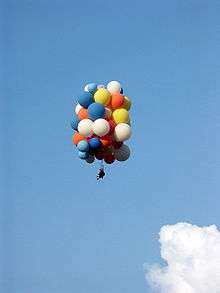Cluster ballooning
Cluster ballooning is a form of ballooning where a harness attaches a balloonist to a cluster of helium-inflated rubber balloons.

Unlike traditional hot-air balloons, where a single large balloon is equipped with vents enabling altitude control, cluster balloons are multiple, small, readily available and individually sealed balloons. To control flight, arrest a climb or initiate a descent, the pilot incrementally jettisons or deflates balloons. Ballast, e.g., bottled water, can also be jettisoned to facilitate ascent.
Famous balloonists
In the Lawnchair Larry flight, Larry Walters, without any prior ballooning experience, attached 42 helium-filled weather balloons to a lawn chair and lifted off in 1982. In defending against charges later filed against him by the FAA, he stated that he intended to rise just a few hundred feet (about 100 metres), but underestimated helium's lifting power, causing his tethering strap to break prematurely. Walters quickly rose to nearly 3 miles (5 km), over 50 times his intended maximum altitude. Walters reportedly had planned to control his altitude by using a pellet gun to selectively pop some of the balloons. However, he was initially hesitant to shoot any balloons, as he was concerned about falling out due to a loss of stability. Reaching a high altitude and seeing no other way of getting down, he eventually shot several of the balloons, initiating his descent.
John Ninomiya's flights have been featured on The Science Channel, The History Channel, TechTV, TLC, and MTV.
The Guinness Book of World Records recognizes the highest altitude attained via cluster ballooning to be that achieved by Mike Howard (UK) and Steve Davis (USA), who on August 4, 2001, over Los Lunas, NM, USA, used 400 helium balloons to reach a height of over 18,300 feet (5,600 m). Larry Walters is estimated to have reached 16,000 feet (4,900 m) in 1982. His record is not recognized, however, because he did not carry a proper altimeter.[1] On June 8, 2013 Joe Barbera, of La Center, WA launched a lawn chair with cluster balloons and recorded a new altitude record of 21,194 feet (6,460 m). This is a pending world record being considered by Guinness Book of World Records[2]
Yoshikazu Suzuki departed from Lake Biwa in Japan on 23 November 1992 with 23 helium balloons. He was spotted by a Japanese coast guard aeroplane on 25 November 1992, located about 800 km offshore over the Pacific Ocean, at altitude between 2,500 and 4,000 m, and was never seen again.
In April 2008, in Brazil, Roman Catholic priest Adelir Antonio de Carli ascended with 1000 balloons. Ground observers lost track of him when he floated out above the ocean, and he was missing until part of his body was recovered by an offshore oil rig support vessel on 5 July 2008. Carli at one point reached an altitude of 6,000 metres (19,685 ft) before losing contact with authorities; his altitude may have indeed been the record for cluster ballooning, but it cost him his life.
Just two months later, in June 2008, FAA licensed pilot Jonathan Trappe attached a cluster of balloons to his standard, unmodified office chair and flew it to an altitude of 14,783 feet. The flight reportedly lasted four hours and covered 50 miles before Trappe returned to earth, retired the chair, and returned it back to his workplace.[3] On May 28, 2010, Sky News reported on Trappe's crossing of the English Channel by cluster balloon. Trappe departed near Challock, England, crossed over the White Cliffs of Dover at St. Margarets Bay, and made landfall again over Dunkirk, France. Trappe then tracked inland, and landed safely in a farmer's cabbage patch.[4] Three years later, Trappe attempted a trans-Atlantic crossing, but his journey stopped short when he was forced to land in Newfoundland.
Other applications
Smaller balloon clusters consisting of several toy balloons are sometimes used for creating flying light effects by using them as a carrier for lightsticks or other small light sources. They can be also used for other amateur scientific experiments, such as making aerial photographs or atmospheric measurements.
Such toy balloons, with or without helium filling, are more readily available than bigger balloons.
See also
- Gas balloon
- Hopper balloon
- Kent Couch
- The Red Balloon, 1956 film
- Danny Deckchair, 2003 film
- Up, 2009 film
References
- Snopes.com , Up, Up, and Away!
- https://www.facebook.com/lawnchairpilots?hc_location=timeline
- ClusterBalloon.com, Chairway to Heaven
- Balloon Daredevil Floats Over English Channel Archived August 22, 2010, at the Wayback Machine , news.sky.com.
External links
| Wikimedia Commons has media related to Cluster ballooning. |
- ClusterBalloon.org, John Ninomiya's cluster ballooning site
- ClusterBalloon.com, Jonathan Trappe's Cluster Balloon Site
- NEWS.BBC.co.uk, Video of world record flight by Ian Ashpole (RealVideo format)
- CBSnews.com, CBS News video of John Ninomiya's flight in Georgia in 2007
- NYtimes.com, "Grab Your Lawn Chair. Float Away" by Thomas Vinciguerra The New York Times, July 13, 2008
- ClusterBalloon.com, Jonathan Trappe's 'Chairway to Heaven' flight
- ClusterBalloon.com, "Carl Fredricksen's Flying Armchair" Website